There’s only one week left to head to Newcastle, Sunderland, Gateshead and Middlesbrough and visit AV Festival, a biennial of contemporary art, music and film which main theme this year is As Slow As Possible.
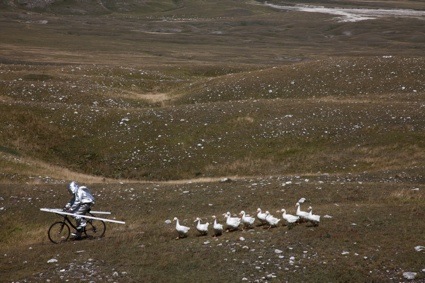 Agnes Meyer-Brandis, The Moon Goose Analogue: Lunar Migration Bird Facility, 2011. Film stills courtesy the artist
Agnes Meyer-Brandis, The Moon Goose Analogue: Lunar Migration Bird Facility, 2011. Film stills courtesy the artist
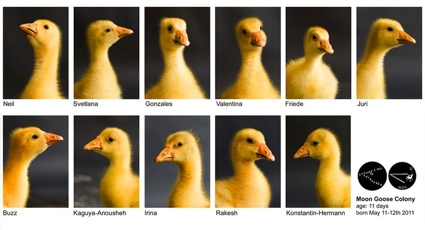 The astronauts: Neil, Svetlana, Gonzales, Valentina, Friede, Juri, Buzz, Kaguya-Anousheh, Irena, Rakesh, Konstantin-Hermann
The astronauts: Neil, Svetlana, Gonzales, Valentina, Friede, Juri, Buzz, Kaguya-Anousheh, Irena, Rakesh, Konstantin-Hermann
One of the works on show is the extremely long-term project that sees Agnes Meyer-Brandis training a flock of young geese to fly to the moon. The whole training started last Spring and according to her schedule, the birds will go on their first unmanned flight to the satellite in 2024. However, the artist plans to accompany them on a later flight, most probably in 2027.
Meyer-Brandis’ scientific experiment is inspired by The Man in the Moone, a story written in the early 17th century by English bishop Francis Godwin, a believer in the Copernican heliocentric system and of the latest theories in magnetism and astronomy. The book tells how Domingo Gonsales flies to the moon and gets to meet an advanced lunar civilization. The adventurer managed to escape the ‘magnetic attraction of the earth’ by harnessing a flock of birds called gansas, specifically trained for the purpose. Some critics regard the story as the first work of science fiction in English.
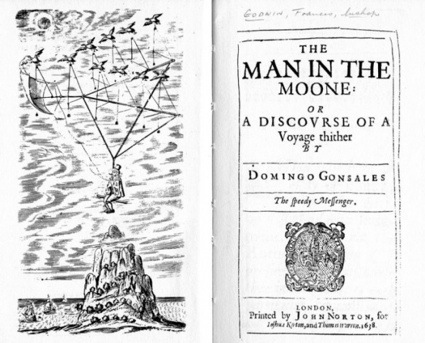 Frontispiece and cover of the first edition of The Man in the Moone, 1638
Frontispiece and cover of the first edition of The Man in the Moone, 1638
Since it has become so difficult to locate moon geese, Meyer-Brandis breeds her own moon geese. She acquired the eggs last April, named each of them after an astronaut, placed them in an incubator, watched over them, witnessed the hatching and imprinted herself on to them as their stand-in mother, just like Konrad Lorenz did with greylag geese.
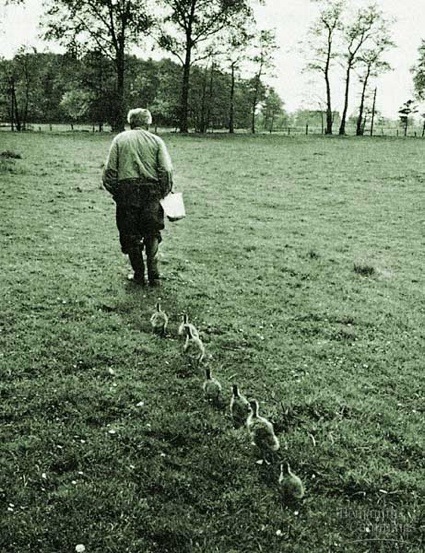 Goslings following Konrad Lorenz as if he were their mother
Goslings following Konrad Lorenz as if he were their mother
The surrogate mother had to spend the weeks following the hatching in close contact with the eleven geese. The astronaut training started almost immediately, the young birds were encouraged to walk in a V-shape –the formation used to tow Godwin’s chariot– taken on expeditions into the mountains for high altitude training, taught how to use morse code devices for improved interspecies communication, and given lectures about astronomy and navigation.
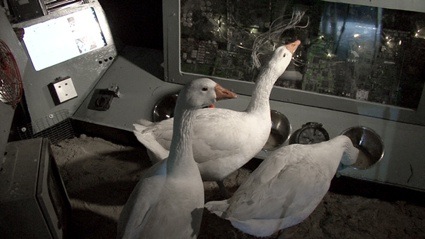 Moon geese sending morse code to the exhibition space. The Moon Goose Analogue (MGA) / Lunar Migration Bird Facility, Italy , 2011/12 @ the artist
Moon geese sending morse code to the exhibition space. The Moon Goose Analogue (MGA) / Lunar Migration Bird Facility, Italy , 2011/12 @ the artist
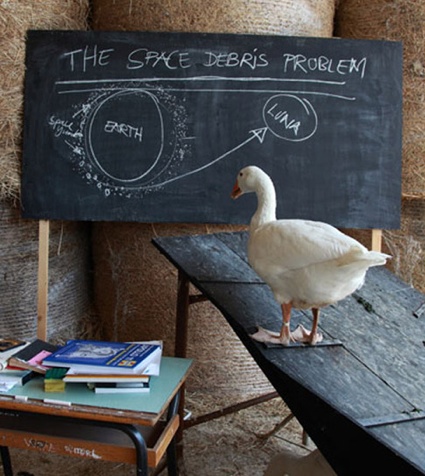
The birds are currently continuing their training at Pollinaria (Italy), in an analogue that simulates the conditions of the Moon. Visitors of the show The Moon Goose Analogue: Lunar Migration Bird Facility in Newcastle can see a scaled model of the remote analogue site, admire the portraits of the astronauts, watch a documentary of the experiment and follow the birds daily life through the screens in the control room at the back of the gallery.
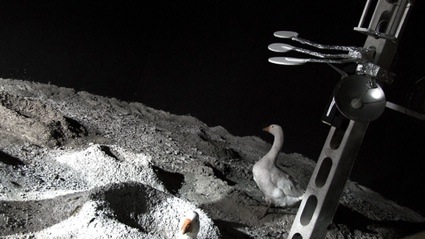 Antenna mast of the moon analogue in Italy, The Moon Goose Analogue (MGA) / Lunar Migration Bird Facility, Italy , 2011/12 @ the artist
Antenna mast of the moon analogue in Italy, The Moon Goose Analogue (MGA) / Lunar Migration Bird Facility, Italy , 2011/12 @ the artist
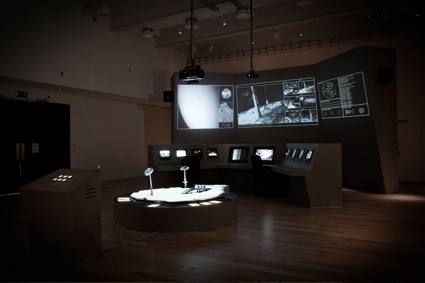 Agnes Meyer-Brandis, The Moon Goose Analogue: Lunar Migration Bird Facility, 2011. Courtesy AV Festival. Photo Colin Davison
Agnes Meyer-Brandis, The Moon Goose Analogue: Lunar Migration Bird Facility, 2011. Courtesy AV Festival. Photo Colin Davison
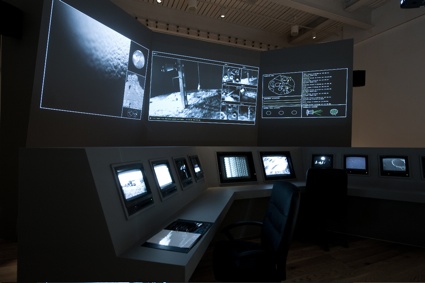 Agnes Meyer-Brandis, The Moon Goose Analogue: Lunar Migration Bird Facility, 2011. Courtesy AV Festival. Photo Colin Davison
Agnes Meyer-Brandis, The Moon Goose Analogue: Lunar Migration Bird Facility, 2011. Courtesy AV Festival. Photo Colin Davison
Documentation of the project and installation The Moon Goose Analogue:
Agnes Meyer-Brandis: The Moon Goose Analogue: Lunar Migration Bird Facility is part of the AV Festival and you can see the film and installation at the Great North Museum: Hancock in Newcastle through 31 March, 2012.
The Lunar Migration Bird Facility was commissioned by The Arts Catalyst and FACT Liverpool. In partnership with: Pollinaria.
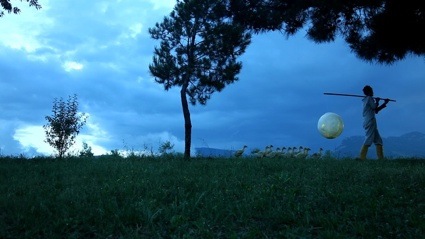 Agnes Meyer-Brandis, The Moon Goose Analogue: Lunar Migration Bird Facility, 2011. Film stills courtesy the artist
Agnes Meyer-Brandis, The Moon Goose Analogue: Lunar Migration Bird Facility, 2011. Film stills courtesy the artist
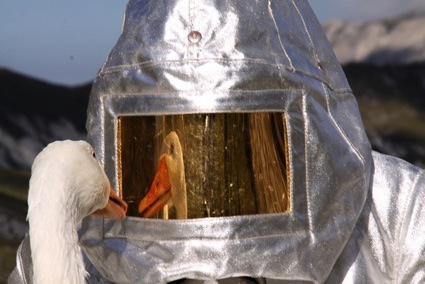 Agnes Meyer-Brandis, The Moon Goose Analogue: Lunar Migration Bird Facility, 2011. Film stills courtesy the artist
Agnes Meyer-Brandis, The Moon Goose Analogue: Lunar Migration Bird Facility, 2011. Film stills courtesy the artist
Also on view at the AV Festival: Slow Motion Car Crash.
Previously: Cloud Core Scanner – an artistic experiment in zero gravity and Biorama 2: the Moon Goose Experiment.
